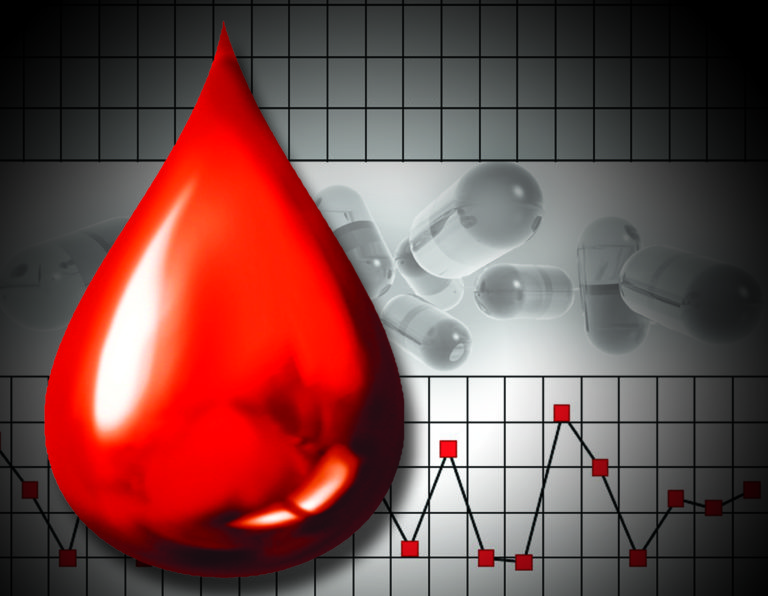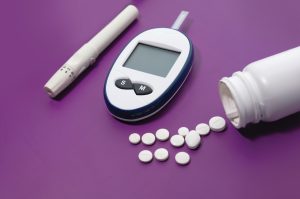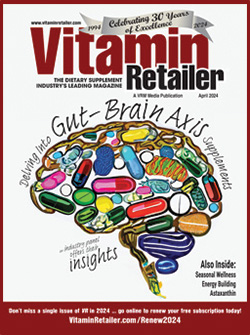As American’s blood sugar levels continue to rise, and consumers are looking for clinically proven supplements to help gain control.
According to the 2011 National Diabetes Fact Sheet, 25.8 million children and adults in the United States—8.3 percent of the population— have diabetes. And in 2010, there were 1.9 million new cases of diabetes diagnosed in people aged 20 years and older. Further, The American Diabetes Association estimates there are 79 million Americans with pre-diabetes and that if current trends continue, one in three Americans will develop diabetes in their lifetime.
It has become clearer that maintaining proper blood sugar levels will help consumers live healthier lives, and because of this, there has been significant growth in the category. Specifically, according to Nutrition Business Journal, diabetes supplement sales grew 50 percent in four years, from $670 million in 2006 to $1 billion in 2010.
While daily exercise, healthy eating and stress management are important in treating and preventing type 2 diabetes, alternative medical therapies such as dietary supplements have proven helpful as well, said Heather Hausenblas, PhD, of Florida-based Reserveage Organics. “If current trends continue, 15 percent of American adults (or more than 37 million Americans) will be living with diabetes by the end of 2015. With this projected increase in diabetes comes a projected increase in supplements that are clinically proven to help with blood sugar levels,” said Hausenblas.
The future of the category is driven by multiple factors, added Craig Klein, MS, CNS, LN, educator for Michael’s Naturopathic in Texas. “As diabetes is growing as a health issue in America, interest in supplements that address blood sugar is also growing. This may be due in part to people looking for alternatives to prescription medications or to use along with their meds. The economy also plays a role; for some consumers supplement use is discretionary whereas for others it is nonnegotiable.”
And according to Scott Steil, president of Minnesota-based Nutra Bridge, the blood sugar category will remain the biggest category of unmet market/customer needs and will blow up over the next few years. “Exponential growth rates in both diabetes and obesity will have to be addressed as the cost of treating these diseases explodes. Given that consumers are becoming more responsible paying for their health care costs, maintaining healthy blood sugar and insulin levels will be a key focus. Investing in supplements that help maintain healthy blood sugar will grow and play a vital role in helping improve our country’s health.”
Consumer Awareness
Metabolic syndrome is a name for a group of risk factors that occur together and increase the risk for coronary artery disease, stroke and type 2 diabetes. According to the American Heart Association, 47 million Americans now have metabolic syndrome, which afflicts 40 percent of people in their 60s and 70s, and that number is expected to rise along with the aging population. Researchers are not sure whether the syndrome is due to one single cause, but all of the risks are related to obesity.
Many consumers who have metabolic syndrome or high blood sugar are unaware that they have a health problem, said Dr. Carl Hastings, vice chairman and chief science officer of Missouribased Reliv International. “The industry has a lot of education to do among consumers. The symptoms of metabolic syndrome can cause very serious long-term damage to the body, even if one feels fine. A person with high blood sugar or metabolic syndrome is twice as likely to develop heart disease and five times more likely to develop diabetes. Other silent symptoms include eye, kidney and nervous system damage over time,” Hastings said.
As such, the recent media attention emphasizing the strong connection between blood sugar levels and weight management has substantially boosted its target audience and brought related products to the forefront of the supplement market, said Kira Schmid, associate director of scientific affairs with Life Extension in Florida. “As individuals realize that blood sugar management affects everything from weight loss to cardiovascular health, interest will continue to grow for this category. The days of blood sugar management being of interest only to diabetics are over.”
As a result, natural products stores around the country are being flooded with consumers who, in one way or another, are looking to benefit from blood sugar products. “We have two to three feet worth of shelving dedicated to the blood sugar support category,” said Ramona Billingslea, marketing manager of Betsy’s Health Foods in Houston, Texas. “Often, customers come in looking for something different without realizing that blood sugar support may actually be helpful for them. For example, people looking for weight-loss or energy support may actually also benefit from blood sugar products. Of course, customers who fall into the metabolic syndrome category or who know they have blood sugar issues that do not require a prescription drug also benefit from being educated about the potential support of blood sugar products.”
Certainly, consumer awareness on the topic can improve, as they tend to be more aware of weight loss products than blood sugar products. With the exponential growth of supplement sales in general and the increase of diabetes and pre-diabetes in this country, awareness of healthy blood sugar products must be growing as well, said Michael’s Naturopathic’s Klein. “The best way for consumers to become educated on this topic is to turn to reliable sources of information. This can come from a health practitioner, the internet or even other sources. It is up to the individual to take responsibility to pursue reliable information.”
Moreover, as reports published by the World Health Organization have estimated that 75 percent of Americans do not meet the recommended daily intake (RDI) of magnesium, Carolyn Dean, MD, ND, author of The Miracle of Magnesium, worries that a lack of magnesium directly leads to diabetes; explaining that a deficiency increases the risk of cardiovascular disease, eye symptoms and nerve damage in diabetics, whereas supplementation can prevent them. Magnesium is a necessary co-factor in the production of energy from sugar stored in the muscles and liver. Most important for diabetics, insulin’s main job requires magnesium; without magnesium, insulin is not properly secreted from the pancreas, and what does get into the bloodstream doesn’t work correctly. At the cell level, magnesium is required to open pathways into the cell for the entrance of blood sugar. If magnesium is in short supply, sugar stays in the bloodstream, and as it becomes elevated, symptoms of diabetes appear. One of the symptoms of diabetes is copious urination— magnesium levels are elevated in diabetic urine, which means greater losses and more symptoms in a vicious cycle of depletion, Dean explained. “Magnesium plays a pivotal role in the secretion and function of insulin; without it, diabetes is inevitable,” she said.
Ingredients & Science
There are a number of ingredients that have come to the forefront of the blood sugar category. Billingslea noted that the science behind cinnamon’s blood sugar support capabilities make it a popular item in Betsy’s Health Foods, “but the options extend far beyond that.” She mentioned Gymnema sylvestre and Coleus forskohlii as her personal favorites for blood sugar control. “Our favorite test is to taste some sugar (such as a chocolate bar), put some Gymnema sylvestre powder from a capsule on our tongue, then taste the sugar again. Of course, on the second time around, what once had tasted so wonderful now tastes like cardboard! If sugar no longer tastes wonderful, then being able to avoid it in our diet should become easier.”
The excessive amount of starch and sugar that Americans consume simply overloads the body’s ability to manage such intake, leading to insulin resistance, added Nutra Bridge’s Steil. Thus, there are several solid options that the natural product industry offers to help in better blood sugar control and improved insulin function. “The key categories that our industry addresses include appetite suppressants, sweet craving control, reducing the rate of glycolysis, insulin sensitizers, starch blockers and sugar blockers. Most of these products can be used in multiple delivery formats including foods, beverages and supplements in both pill and chewable options,” he said.
Enter Nutra Bridge’s ingredient InSea2™, which will change the way consumers can manage the impact of starch and carbohydrates on blood sugar and insulin response, said Steil, noting that it is the only commercially available product that significantly blocks both alpha amylase and alpha glucosidase enzymes (meaning that is blocks the breakdown of both starch and table sugar). “As a result, it offers more complete control of blood sugar levels versus more traditional starch and carbohydrate blockers. Given that it is almost impossible to avoid the consumption of starch and complex carbohydrates in today’s diet, supplementing with InSea2 can reduce the quick spike in blood glucose and insulin associated with these compounds,” Steil said.
InSea2 is present in Life Extension’s CinSulin, a clinicallyproven novel form of cinnamon to support healthy glucose metabolism. Life Extension has identified a highly purified water-soluble cinnamon extract standardized to the bioactive type-A polymers using a patented process that eliminates the naturally occurring fatsoluble aldehyde toxins. In a recent double-blind, placebo-controlled, clinical trial, a group of maturing individuals (average age 61) taking 500 mg per day of the cinnamon extract contained in the CinSulin formula experienced an average decline of 12 mg/dL in fasting blood glucose after only two months. “This novel cinnamon extract also produced a significant decrease in aftermeal glucose spikes (an average of 32 mg/dL) after ingestion of 75 g of carbohydrates,” said Ron Antriasian, director of sales and business development at Life Extension.
Another major factor in maintaining healthy blood sugar is managing after meal glucose spikes. Green coffee extract is a natural compound that moderates post-meal glucose levels. In fact, a 400 mg dose was shown to induce a remarkable 24 percent drop in after-meal blood sugar after 30 minutes while 200 mg generated a 14 percent drop, according to Adina Myerhoff, product development manager at Life Extension. “The benefits are attributed to chlorogenic acid, a polyphenol found in the green coffee bean. Another way chlorogenic acid supports healthy after-meal glucose levels is by targeting the alpha-glucosidase enzyme. This intestinal enzyme breaks apart complex sugars and enhances their absorption into the bloodstream,” said Myerhoff.
Life Extension’s Calorie Control Weight Management Formula with CoffeeGenic is a natural blueberry-flavored powdered drink mix formulated with five key ingredients shown to promote weight management and help manage after-meal glucose levels. Calorie Control contains ingredients like LuraLean® propolmannan, which slows the rapid emptying of ingested food into the small intestine, reducing the surge of glucose entering the bloodstream. “LuraLean works more effectively than other fibers because its enzymes have been removed, sparing it from degradation in the digestive tract,” said Myerhoff. “This action enables LuraLean to form a stable viscous barrier to help impede calorie absorption and maintain its sponge-like activity throughout the digestive tract.”
Additionally, Reliv’s GlucAffect® is an example of a product that has been formulated with ingredients that work synergistically to support healthy blood sugar levels and healthy cellular function, said Hastings. GlucAffect’s patented formula has been clinically shown to help manage blood sugar levels and aid in weight loss, with a combination of ingredients such as cinnamon, CoQ10 and Pyncogenol®. The recent addition of the Reliv exclusive ingredient, LunaRich® soy powder, to GlucAffect provides additional health benefits that support optimal cellular metabolism and function.
Further, emerging clinical trials are showing the positive effects for resveratrol and cocoa in managing blood sugar levels, said Reserveage’s Hausenblas. “There are clinical trials that are revealing that resveratrol and cocoa supplements are both safe and effective for managing blood sugar levels (and provide a safe alternative for prediabetics or diabetics to obtain their resveratrol and cocoa without eating foods/drinks that may increase their blood sugar levels),” she said. “Preliminary research on resveratrol has shown that it helps to improve insulin sensitivity as well as support glucose metabolism. We expect to see much more research on resveratrol’s role in supporting blood sugar imbalance.”
Of significance, a recent clinical trial found that resveratrol improves blood sugar management. In this threemonth, open-label, controlled study, investigators enrolled 62 patients with type 2 diabetes who were already taking standard oral anti-diabetes medications. The researchers then randomly assigned half the patients to take 250 mg of resveratrol daily along with their medication. At the end of three months, the patients taking the resveratrol had significant improvement in hemoglobin A1c, total cholesterol, and total and systolic blood pressure compared to the controls. In short, these results support that resveratrol supplementation improves glycemic control and the associated risk factors in patients with type 2 diabetes mellitus, said Hausenblas.
In addition, new research reveals that patients with heart failure and type 2 diabetes showed improvement after three months of consuming epicatechinenriched cocoa (epicatechin is a flavonoid found in dark chocolate), Hausenblas continued. “A new delivery system— Cocoawell—now exists and provides all the health benefits of cocoa without the added calories and sugar associated with eating chocolate. This is especially important for diabetics who must control their blood sugar levels.”
From Retailers to Consumers
Undoubtedly, if retailers choose products that contain ingredients with scientific validation and proven efficacy, it will be easier for consumers to make educated decisions. Specifically, a successful marketing campaign for blood sugar products will focus on the cardiovascular and metabolic benefits of maintaining healthy blood sugar levels, as well as its role in weight management, said Life Extension’s Antriasian.
Retailers can play a strong role in educating the consumer on treatment options if blood sugar management is a set goal, added Nutra Bridge’s Steil. “Also, retailers could dramatically expand the product offering in their store to help provide better solutions to those consumers who are battling metabolic syndrome. More ‘real estate’ for this category at the retail level will help drive consumer awareness.”
And retailer Billingslea admits that the onus falls on her store’s staff as well as other retailers to provide their customers with the best information possible. “Safety is one of our first concerns at Betsy’s, so we are particularly careful with blood sugar products,” she said. “We ask if a person is already taking a blood sugar product, especially prescription drugs, so that we don’t risk someone taking something that is contraindicated. We also like to encourage our customers to see their health care providers with their blood sugar concerns if they have not already done so because we know how important this category is to overall health.”
Eight Steps to Reversing Diabetes
According to Mark Hyman, MD, the entire spectrum of diabesity (the continuum of abnormal biology that ranges from mild insulin resistance to full-blown diabetes) including all of its complications—diabetes, elevated blood sugar, blood pressure and cholesterol—are simple downstream symptoms that result from problems with diet, lifestyle and environmental toxins interacting with our unique genetic susceptibilities. “Most people just need to eliminate the things that are sending their biology out of balance and include what’s needed to help the body rebalance itself. For most, the interventions required are extremely simply and extraordinarily effective,” Hyman said.
In a recent article published in the Huffington Post, Hyman outlined a comprehensive eight-week plan for overcoming diabesity in all its forms. Below is a sneak peak of the steps; the full version can be seen in Hyman’s book, The Blood Sugar Solution.
1. Get the right tests. Most doctors focus on fasting blood sugar. This is actually a poor indicator of diabesity. The best test to tease out the condition is an insulin response test where insulin levels are measured fasting and then one and two hours after a glucose drink. Demand this test from your doctor.
2. Get smart about nutrition.
Despite the media hype and the seeming confusion amongst doctors, the basics of nutrition are extremely simple. Eliminate sugar and processed carbohydrates, include whole real foods like lean protein (chicken or fish), veggies, nuts, seeds, beans and whole grains.
3. Get the right supplements.
There has recently been a frenzy of negative reports about supplements. Most of them are unfounded. Supplements are an essential part of treating diabesity. A good multivitamin, vitamin D, fish oil and special blood sugar-balancing nutrients like alpha lipoic acid, chromium polynicotinate, biotin, cinnamon, green tea catechins and glucomannan should also be included.
4. Get relaxed.
Stress is a major unrecognized contributor to insulin resistance and blood sugar imbalance. Push your pause button every day with deep breathing, visualization, yoga and other relaxation techniques.
5. Get moving.
Aside from changing your diet, exercise is probably the single best medication for diabesity. Walk for at least 30 minutes every day. For some, 30-60 minutes of more vigorous aerobic exercise four-six times a week may be necessary.
6. Get clean and green.
Environmental toxins also contribute to diabesity. Filter your water, look for green cleaning products and avoid plastics when you can.
7. Get personal.
While the steps above will address 80 percent of the problems with diabesity, some may need to take additional steps to optimize key areas of their biology. Remember, the medicine of the future is personal medicine. Seek out your own biological imbalances and look for ways to address them.
8. Get connected.
Research is beginning to show that we get better more effectively when we get together. Invite your friends, families and neighbors to change their diets and lifestyle along with you. Together we can all take back our health.




![[Sponsored Video] Special Report: Bergamonte®, the Untold Story](https://vitaminretailer.com/wp-content/uploads/2023/06/sponsored-video-special-report-b-300x169-1707947265.jpg)








